New York, NY, July 17, 2018 - The common thread for this year's 11th annual City of Water Day, held on Saturday, July 14th at the Seaport District in Lower Manhattan and at dozens of "In Your Neighborhood" waterfront sites in all five boroughs, Yonkers, and New Jersey—was "access to the water."
New York Sea Grant, along with its partner the Science and Resilience Institute at Jamaica Bay (SRIatJB), took part in the festivities in Queens.
As part of City of Water Day and the Jamaica Bay Festival (sponsored by the Jamaica Bay - Rockaway Parks Conservancy and the American Littoral Society Northeast Chapter), SRIatJB gave dockside tours of the City of New York (CUNY) I Research Vessel.
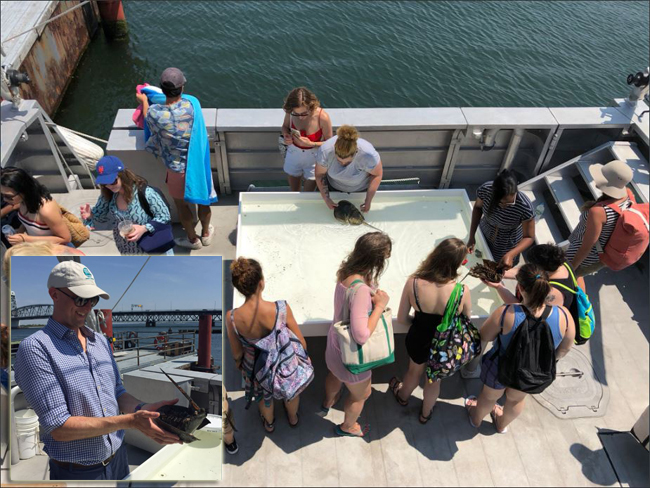
Credit: Helen Cheng, Chrissy Colon.
The Institute also brought aboard professor Christina Colon and her students from CUNY Kingsborough to the vessel (pictured above) to help out with a touch tank featuring animals found in Jamaica Bay. SRIatJB's Executive Director Adam Parris (pictured above, in inset photo) is holding an American horseshoe crab, which was recently the spotlight of a podcast produced by SRIatJB's Helen Cheng, a NYSG Jamaica Bay Coastal Resiliency Specialist. Cheng is pictured below (at far right) along with Parris (at far left) and others, including colleagues from SRIatJB and CUNY Kingsborough.
For more on the podcast series at "Helen Cheng’s Jamaica Bay Podcast Series Tells Listeners About Life in the Bay."
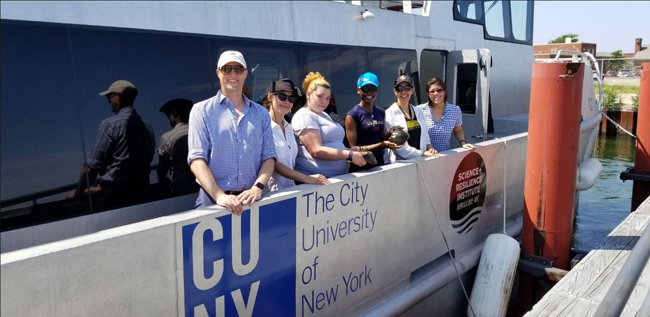
Credit: Helen Cheng, Chrissy Colon.
SRIatJB's boat tour and interactive touch tank experience was just one of the festival’s many "In Your Neighborhood activities," which were organized by some of the more than 1,000 partners of the Waterfront Alliance, organizers of the day.
From free kayaking to rowing to hands-on workshops, these activities offered something closer to home to access some of our region’s 700+ miles of waterfront. In 2017, there were a record-setting 57 "In Your Neighborhood" locations—affirmation of the strong citywide spirit of City of Water Day.
The City of Water Day festival hub was at Piers 16 and 17 in the historic Seaport District in Lower Manhattan, a few steps south of Brooklyn Bridge Beach. Activities included free rowing, narrated PortNYC boat tours, a cardboard kayak race, children's events and a activity fair where numerous Waterfront Alliance partners offered games, giveaways, performances and more.
For more on the day's experiences, see the images below and check out the tweets from partners and participants alike who used #CityOfWaterDay on Twitter. NYSG also has coverage of last year's City of Water Day via "In Photos: NYSG's Estuary Education & Underwater Exploration Highlight 10th Annual NYC City of Water."
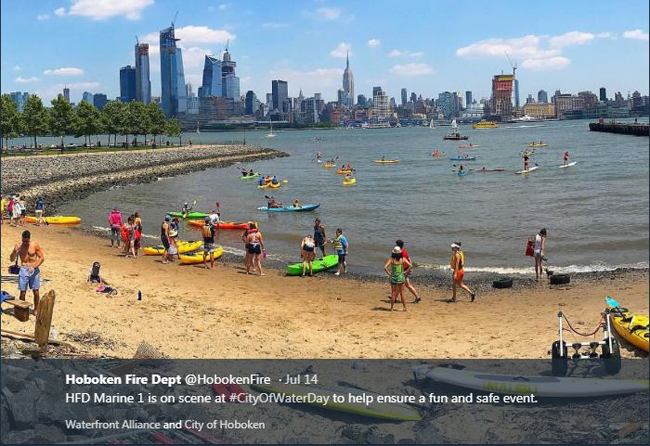
Hoboken Fire Department - Marine 1 was on scene at #CityOfWaterDay to help ensure a fun and safe event. Credit: HFD.
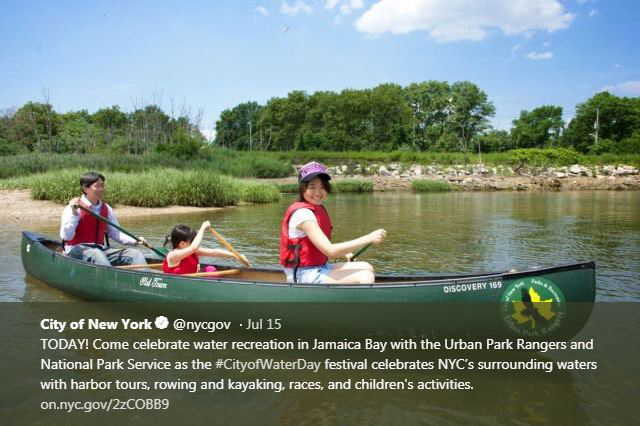
The Urban Park Rangers and National Park Service encouraged folks to enjoy water recreation with them in Jamaica Bay during #CityofWaterDay. Credit: City of New York.
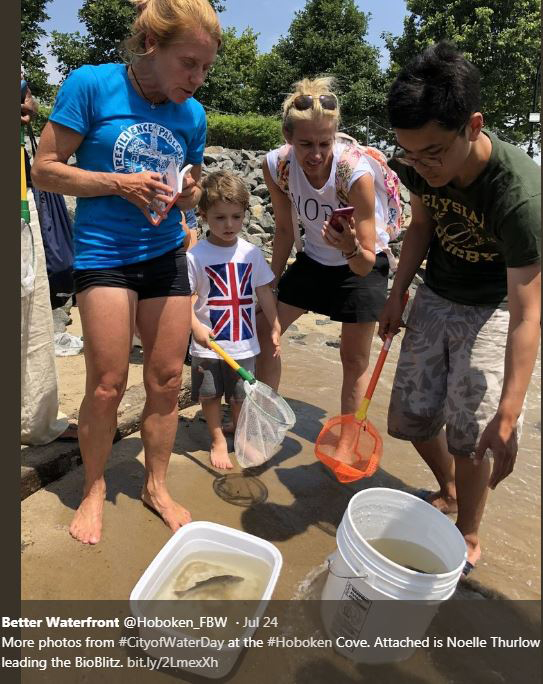
#CityofWaterDay at the Hoboken Cove: Noelle Thurlow leads the bio blitz. Credit: Better Waterfront.
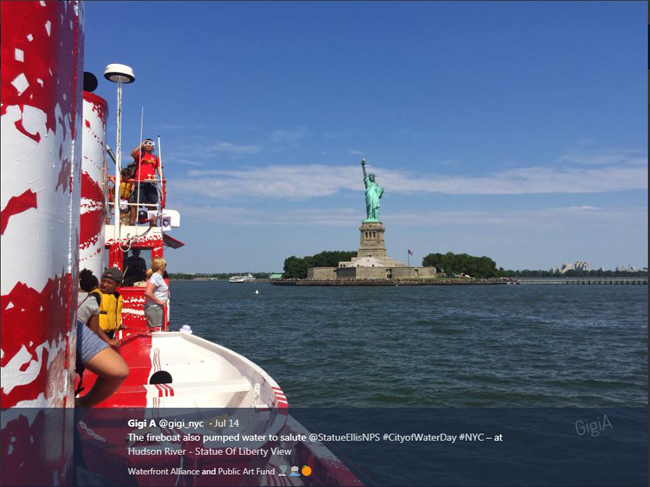
A fireboat in New York's Harbor pumped water to salute The Statue of Liberty #CityofWaterDay Credit: Gigi A.
2018 Waterfront Conference Word of the Day: Collaboration
Another annual event hosted by the Waterfront Alliance is the Waterfront Conference, which is held on a boat that navigates New York's waterways from Hudson River Park at Pier 40.
This year’s Waterfront Conference, “Cities on the Edge,” took place on May 8th aboard the Hornblower Infinity and was attended by more than 500 people. Remarks from Manhattan Borough President Gale A. Brewer kicked off this full day of dialogue and discourse with experts on our shared resilience challenges.
With topics crowdsourced through a public request for proposals, the conference offered 17 sessions and more than 50 speakers.

Credits: Waterfront Alliance; (inset) The River Project.
Early in the Waterfront Conference, Chris Ward, Waterfront Alliance chairman and senior vice president and chief executive of Metro New York, AECOM (an American multinational engineering firm), was blunt.
“There’s not enough money to go around,” he said as a panelist for a discussion about cities meeting the challenges of water management and climate change.
"In order to address the challenges being faced by vulnerable waterfront neighborhoods in NYC, we need a new model for extracting wealth from the economy to fund this necessary work."
Despite the sometimes pessimistic and plainspoken realities articulated through the day, the tenor of the conference was upbeat. And the key to success was clear: Partnerships. Collaborations. Opportunities.
“We have seen local governments step up and prove their overall resilience,” said Otis Rolley, 100 Resilient Cities regional director for North America. “When we help cities develop resilience strategies, we ask them not to think in terms of the boundaries of their cities. The reality is that the water is not going to stop at the city’s border. While much of the work and implementation may be done by the respective city, they can’t do it alone.”
The conference concluded with another nod to collaborative work, when students from The City College of New York’s ASLA Student Chapter presented a report from their interactive resilience and mapping workshop. Throughout the day, conference-goers had visited the students’ presentation, examining a map of New York City layered with areas prone to flooding, storm-surge, and with social and economic vulnerabilities. Then, they were given tracing paper to place over the map and colorful markers to sketch their own design solutions for environmental justice.
“This could be a great tool as a community outreach proposition,” said one of the students as she showed the results of the mapping workshop at the end of the day. “When people let go of being shy, it uncovers their values and is an opportunity to see things in a different way. Layering is an active process and build on each other’s ideas in real time.”
“It was interesting to see the layering of ideas,” another student said. “Sometimes we forget about the expertise that other people have. But this exercise pulls a lot of people together. The collaborative nature of this can be powerful.”
For more thoughts from the annual conference, see the images below and check out the tweets from attendees and sponsors who used #WaterfrontConference on Twitter. You can also check out photos via the Waterfront Alliance's Flickr page. NYSG also has coverage of last year's City of Water Day via "Sea Grant Provides Hurricane & Climate Resources at Waterfront Alliance's Annual NYC Conference."
New York Sea Grant and Resilience Education
The Waterfront Alliance is a coalition of some 950+ organizations — which includes New York Sea Grant — that work together to bring about real change to our region’s 700 miles of shoreline.
Below are some of Sea Grant's recent efforts in and around New York City.
And for more, see NYSG's coverage of last year's conference, "Sea Grant Provides Hurricane & Climate Resources at Waterfront Alliance's Annual NYC Conference."
More Info: New York Sea Grant and SRIatJB
The Science and Resilience Institute @ Jamaica Bay
(SRIJB) is a research center focused on enhancing environmental,
social, and economic resilience in communities of Jamaica Bay funded by
the Rockefeller Foundation and the City of New York.
New York Sea Grant (NYSG), a cooperative program of Cornell University
and the State University of New York (SUNY), is one of 33 university-based
programs under the National Oceanic and Atmospheric Administration’s
National Sea Grant College Program.
Since 1971, NYSG has represented a statewide network of integrated
research, education and extension services promoting coastal community
economic vitality, environmental sustainability and citizen awareness
and understanding about the State’s marine and Great Lakes resources.
Through NYSG’s efforts, the combined talents of university scientists
and extension specialists help develop and transfer science-based
information to many coastal user groups—businesses and industries,
federal, state and local government decision-makers and agency managers,
educators, the media and the interested public.
The program maintains Great Lakes offices at Cornell University, SUNY
Buffalo, SUNY Oswego and the Wayne County Cooperative Extension office
in Newark. In the State's marine waters, NYSG has offices at Stony Brook
University in Long Island, Brooklyn College and Cornell Cooperative
Extension in NYC and Kingston in the Hudson Valley.
For updates on Sea Grant activities: www.nyseagrant.org has RSS, Facebook, Twitter, and YouTube links. NYSG offers a free e-list sign up via www.nyseagrant.org/nycoastlines for its flagship publication, NY Coastlines/Currents, which is published quarterly. Our program also produces an occasional e-newsletter,"NOAA Sea Grant's Social Media Review," via its blog, www.nyseagrant.org/blog.